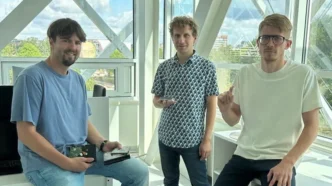Even before the rise of generative AI, the digital world was buckling under the weight of its own data. Now, with AI models generating massive volumes of synthetic content daily, the demand for storage has reached a breaking point—straining infrastructure, driving up energy use, and pushing the limits of what today’s technologies can handle. That’s where DNA data storage is stepping in, and Lithuania’s Genomika is at the forefront of this transformation.
Founded in 2019 in Kaunas by Dr. Lukas Žemaitis and Ignas Galminas, the biotech company is building a new foundation for ultra-dense, secure, and long-lasting digital storage by using DNA—the original blueprint of life.
Unlike hard drives or magnetic tapes that degrade within decades, DNA can preserve information for centuries, even millennia. Genomika’s approach could reshape how industries—from scientific research to space exploration—store and protect critical data for the long term.
Genomika Joins DiDAX to Tackle Global Storage Limits
Genomika’s latest leap comes through its role in the DiDAX project, one of Europe’s most ambitious DNA storage initiatives. Backed by €5.2 million and supported by the EIC Pathfinder Challenge, the four-year research effort aims to solve the limitations of today’s digital storage systems: high power consumption, rare earth dependencies, and short data lifespans.
As one of only two commercial companies in a consortium that includes institutions like ETH Zurich, TU Munich, Technion, and TU Delft, Genomika is tasked with advancing DNA reading and encryption methods. Their goal: to create scalable, high-throughput systems that make DNA storage viable not just in the lab, but across real-world industries.
This isn’t Genomika’s first foray into EU-funded research. The company previously led the DNAMIC project (DNA Microfactory for Autonomous Archiving), where it developed a self-contained, low-energy system that encodes, synthesizes, stores, and retrieves data—all on a compact platform. They’ve even encoded the Lithuanian national anthem and historical photos into DNA, demonstrating the technology’s potential to preserve culture and memory indefinitely.
With over €10 million in combined grant funding to date, Genomika is now building on this foundation, focusing on encryption, automation, and practical deployment across diverse environments—including space.
Practical Uses of DNA Data Storage
What makes DNA an exceptional storage medium isn’t just its density or durability—it’s also its versatility. Genomika’s innovations could soon power applications far beyond data centers.
In the DiDAX project, the company is developing portable, low-energy DNA reading systems designed for extreme environments—like space missions—where traditional lab equipment isn’t feasible. By eliminating the need for bulky centrifuges and freezers, these tools could enable compact archiving and retrieval systems for spacecraft and satellites.
Another futuristic use case? Embedding DNA into physical materials to create self-documenting products. Imagine a machine part carrying its own maintenance logs, usage instructions, and origin details—permanently stored in DNA encoded directly within the component. It’s not science fiction; it’s where DNA data storage is headed.
Eitan Yaakobi, the DiDAX project coordinator, described this as a step toward “self-aware products” that retain data throughout their lifecycle—without relying on fragile external databases or cloud storage.
For Genomika, the mission is clear: take DNA storage out of the lab and into everyday use. From ultra-dense archives to on-board data for future space missions, the company is positioning itself as a pioneer in the next era of digital preservation—where biology and information technology converge.













